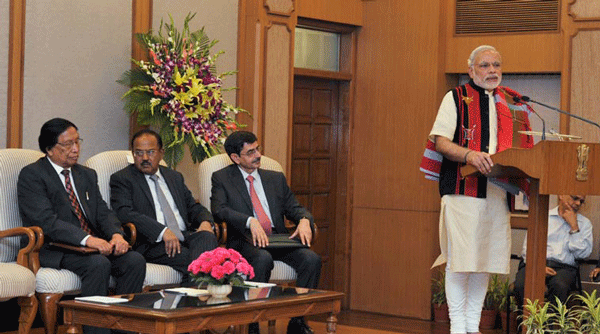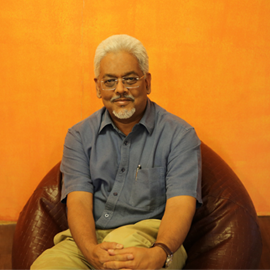Naga deal decoded: this could end India's longest insurgency

The deal
- The govt of India and Naga insurgent group NSCN (IM) signed a peace accord on 3 August
- It is a framework agreement that lays the ground for further negotiations
- It has been hastened by the ill health of NSCN (IM) leader Isak Swu
The crux
- Nagas believe they were not part of India, whether through conquest or consent
- They declared their independence on 14 August 1947
- Several previous attempts to negotiate have failed
The future
- Naga groups have agreed to work with the govt to set up a federal relationship
- A Pan-Naga Council could be formed across the state lines of Nagaland, Manipur, Arunachal and Assam
- This would look after the welfare of Naga tribes across the Northeast
- Other Naga insurgent groups seem to be on board
- The Meiteis of Manipur may form the only roadblock to these proposals
The historic peace accord with the National Socialist Council of Nagaland (Isak-Muivah), signed on 3 August 2015, has been a long time coming.
It was expected that the agreement would be announced in a few months' time. What seems to have hastened it is the indisposition of the chairman of the NSCN (IM), Isak Chishi Swu. He is in a hospital in the Capital, reportedly with multiple organ failure. He is supposed to have signed the agreement while in a wheelchair.
Also read: Manipur-Myanmar attacks: the violence is unlikely to stop
Framework put in place
This is only a framework agreement. The details of the accord are yet to be fleshed out. It is likely to be followed by more detailed agreements and negotiations.
Had the framework agreement not been signed now, a new chairman in place of Isak Swu would have to be elected.
Like Swu, he would have to be a Sema from Nagaland, to show Naga unity across states. Thuingaleng Muivah, the General Secretary of NSCN (IM), is a Naga from Manipur.
While that would not be a difficult task to accomplish, it would certainly be time consuming. It is widely believed that Q Tuccu, a member of the NSCN (IM)'s collective leadership, fits the bill perfectly and would have been the front-runner among other Semas in the organisation - like AZ Jami, Vikiye Awomi and Tongmath Wangnao - to take Swu's place.
However, the internal consultative and consent generating processes that the NSCN (IM) would have to undertake have been shortened by putting a framework agreement in place while Swu is still alive.
A grim-looking Muivah, who signed the framework agreement, may have also done so as a special gesture to his ailing long-term friend and comrade. This way, Swu's ambition of bringing honourable peace to the Nagas in his lifetime will also be achieved.
Some of the international legal and constitutional experts advising the Naga leaders are scheduled to be in Delhi later this month.
They include, among others, Michael von valt Praag, a professor of international law at the Golden Gate University in San Francisco; Yash Ghai, an Indian-origin Kenyan academic of Constitutional Law; and Anthony Reagan, professor of law at the Australian National University.
They have been helping the NSCN (IM) work out the details of the relationship between the Nagas and the Centre.
The root of the problem
The crux of resolving the Naga problem has been their position that they were not a part of India either by conquest, consent or accession.
The Nagas had declared their independence a day earlier than India, on 14 August 1947.
The initial position of the Naga leaders was thus for complete sovereignty and independence from India. When this was not acceptable to the leaders of independent India, the Nagas boycotted the first general election of India in 1952 and launched an armed insurgency.
Although Prime Minister Jawaharlal Nehru advocated effective military action against the Naga insurgents, he did not propose a "military solution", contrary to modern Naga folklore.
Since then, several attempts to negotiate with the Nagas have failed. Some were rejected outright by the underground Naga insurgents, and others were so insincere that they were not worth the paper they were written on.
The Nagas felt they weren't part of India by conquest or consent. They declared independence on 14 August 1947
These negotiations include the nine-point agreement with Sir Akbar Hydari in June 1947; the 16-point agreement with the Naga Peoples' Convention in 1960; the cease-fire and negotiations of 1964 with Rev. Michael Scott, Jayaprakash Narayan and BP Chaliha; the six rounds of talks held between the Naga underground and Prime Minister Indira Gandhi between 1966 and 1967; and the Shillong Accord of November 1975.
The rejection of the Shillong Accord catapulted Isak Swu, Thuingaleng Muivah and SS Khaplang into the leadership position of the Naga armed insurgency.
Khaplang was to split from the original National Socialist Council of Nagaland and form his own group because of the machinations of the Indian intelligence agencies, who wanted to break the NSCN.
An 18-year process
A cease-fire was reached between the Government of India and the NSCN (IM) in August 1997. This was after Prime Minister PV Narasimha Rao met Muivah and Swu in Paris in 1995 to end hostilities and explore a negotiated settlement.
The cease-fire was to facilitate a dialogue for a political settlement with the NSCN (IM), the largest, strongest and most organised group of Naga insurgents.
The dialogue initially took place in Bangkok, Amsterdam, Paris and Geneva till Prime Minister Atal Bihari Vajpayee suggested that a more continuous process of negotiation would be possible only if the underground Naga leaders came back to India.
Prime Minister Manmohan Singh followed through with this process. The current ceasefire and dialogue has lasted 18 years.
The key issues
Broadly, there have been two issues in the negotiations with the NSCN (IM): the political status of the Nagas and the integration of all the contiguous Naga areas in India's Northeast.
The demand for full independence and sovereignty were de-escalated by the Nagas after protracted negotiations.
Initially, they proposed that India and Nagaland should become "two nations inseparably bound". After many ups and downs, they decided to seek a re-negotiated federal relationship with India.
The nature of this proposed federal relationship will be the crux of future negotiations between the two sides.
Negotiations over a unique federal relationship with India meant that the division of competencies - subjects in the Union, State and Concurrent Lists of the Indian Constitution - would be discussed. These details still have to be worked out.
Prime Minister Rao met the NSCN (IM) leaders in Paris in 1995. Two years later, a cease-fire was reached
Another special feature of the detailed agreement is likely to be a separate arrangement on land and mineral rights in the Naga areas.
The Naga areas are rich in petroleum and natural gas, coal and other minerals. The NSCN (IM) has been demanding a Constitutional Guarantee about their "absolute right" over land and mineral resources.
Currently, the royalty on minerals that goes to a state is 22% in the rest of India but the NSCN (IM) wants this to be raised. However, it is unclear to which administrative body these royalties will accrue.

The political situation
The major political arrangement that is likely to emerge out of the agreement is the formation of a Pan-Naga Council.
This non-state body is likely to be elected by all Nagas residing in the contiguous areas of Nagaland, Manipur, Arunachal Pradesh and Assam. Its powers would be the subject of the negotiations carried out within the parameters of the framework agreement.
It is expected that Nagas in each state would get an elected autonomous council, which would look after their economic and other developmental affairs.
However, the creation of such bodies immediately in Assam and Arunachal Pradesh could be more difficult than in Manipur, where an Autonomous District Council for the Naga hill districts already exists. The powers of these autonomous entities would also be the subject of negotiation.
As for the integration of the Naga-inhabited areas, the very idea of merging parts of Manipur, Arunachal Pradesh and Assam with the present state of Nagaland is enough to create tensions within the states which stand to lose territory. The actual process of integration would be even harder.
The NSCN (IM) has accepted that while the integration of contiguous Naga areas would remain on the negotiating table, the time for actual integration may not be opportune at present.
They would, therefore, continue to discuss it with Delhi, recognising that political consensus across states would be required for changing state boundaries. This way, the issue of integration would stay alive but be deferred.
Other sticking points
The two major issues that still need to be tackled are - the reaction of the other Naga insurgent groups, the Naga civil society and that of the non-Nagas of Manipur - especially the Meiteis, who live in the Imphal Valley.
Most of the other Naga insurgent groups have apparently been briefed that a settlement was on with the NSCN (IM). Some of them had been camping in Delhi for most of July, meeting officials in the Ministry of Home Affairs.
Their fear that they would be left out of an agreement has been assuaged by assuring them that once the framework agreement is signed, they would also be included in the subsequent developments that follow.
This might explain the silence of the other rebels to the news of the agreement with the NSCN (IM).
Muivah and his colleagues would now have to canvass public support for the framework agreement within Nagaland and in other Naga-inhabited areas. Indeed, they have already been doing so.
In the last two months, nearly 250 representatives of various Naga tribal and other organisations have been included in the negotiations with the Indian interlocutors in batches of 10 to 15 at a time.
This transparency has meant that they would have gone back home satisfied that the NSCN (IM) was not compromising Naga interests.
The reaction of the Meiteis and the non-Naga tribes of Manipur, however, could be more difficult to handle. This might also take some time to surface as the inhabitants of the Imphal Valley deal with devastating floods.
With a Bharatiya Janata Party government at the Centre, it is unlikely that the Ibobi Singh-led Congress government would be able to foment the kind of trouble it did in the past with the Congress government at the Centre being a mute spectator.
First published: 4 August 2015, 10:26 IST






![BJP's Kapil Mishra recreates Shankar Mahadevan’s ‘Breathless’ song to highlight Delhi pollution [WATCH] BJP's Kapil Mishra recreates Shankar Mahadevan’s ‘Breathless’ song to highlight Delhi pollution [WATCH]](https://images.catchnews.com/upload/2022/11/03/kapil-mishra_240884_300x172.png)

![Anupam Kher shares pictures of his toned body on 67th birthday [MUST SEE] Anupam Kher shares pictures of his toned body on 67th birthday [MUST SEE]](https://images.catchnews.com/upload/2022/03/07/Anupam_kher_231145_300x172.jpg)






